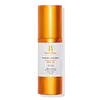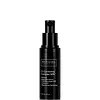What's inside
What's inside
 Key Ingredients
Key Ingredients

 Benefits
Benefits

 Concerns
Concerns

No concerns
 Ingredients Side-by-side
Ingredients Side-by-side

Zinc Oxide 17.5%
Cosmetic ColorantDimethicone
EmollientAscorbic Acid
AntioxidantCaprylic/Capric Triglyceride
MaskingPolysilicone-11
Stearalkonium Bentonite
Gel FormingMica
Cosmetic ColorantCamellia Sinensis Leaf Extract
AntimicrobialLinoleic Acid
CleansingCholesterol
EmollientTartaric Acid
BufferingAmaranthus Caudatus Seed Oil
EmollientHordeum Vulgare Extract
EmollientTriticum Vulgare Germ Oil
EmollientSqualane
EmollientCI 77891
Cosmetic ColorantPolyhydroxystearic Acid
EmulsifyingTocopheryl Acetate
AntioxidantPolyglyceryl-3 Polyricinoleate
EmulsifyingIsostearic Acid
CleansingLecithin
EmollientPropylene Carbonate
SolventCI 77491
Cosmetic ColorantCoco-Caprylate/Caprate
EmollientPolyglyceryl-6 Polyricinoleate
EmulsifyingDisodium Stearoyl Glutamate
CleansingDilinoleic Acid/Butanediol Copolymer
Castor Oil/Ipdi Copolymer
Zinc Oxide 17.5%, Dimethicone, Ascorbic Acid, Caprylic/Capric Triglyceride, Polysilicone-11, Stearalkonium Bentonite, Mica, Camellia Sinensis Leaf Extract, Linoleic Acid, Cholesterol, Tartaric Acid, Amaranthus Caudatus Seed Oil, Hordeum Vulgare Extract, Triticum Vulgare Germ Oil, Squalane, CI 77891, Polyhydroxystearic Acid, Tocopheryl Acetate, Polyglyceryl-3 Polyricinoleate, Isostearic Acid, Lecithin, Propylene Carbonate, CI 77491, Coco-Caprylate/Caprate, Polyglyceryl-6 Polyricinoleate, Disodium Stearoyl Glutamate, Dilinoleic Acid/Butanediol Copolymer, Castor Oil/Ipdi Copolymer
Water
Skin ConditioningTetrahexyldecyl Ascorbate
AntioxidantPentylene Glycol
Skin ConditioningDimethyl Isosorbide
SolventHydrolyzed Eruca Sativa Leaf
AntioxidantGlycerin
HumectantZea Mays Starch
AbsorbentCetearyl Glucoside
EmulsifyingHydrogenated Lecithin
EmulsifyingAcetyl Zingerone
AntioxidantPalmitoyl Glycine
CleansingCyclopentasiloxane
EmollientGlyceryl Caprylate
EmollientPlantago Lanceolata Leaf Extract
AntimicrobialDiglucosyl Gallic Acid
Squalane
EmollientSodium Carboxymethyl Beta-Glucan
CleansingEuterpe Oleracea Fruit Extract
Ergothioneine
AntioxidantPunica Granatum Extract
AstringentTocopherol
AntioxidantUbiquinone
AntioxidantAcrylates/C10-30 Alkyl Acrylate Crosspolymer
Emulsion StabilisingTriethanolamine
BufferingTocopheryl Acetate
AntioxidantLeuconostoc/Radish Root Ferment Filtrate
AntimicrobialPhenoxyethanol
PreservativeDisodium EDTA
PPG-12/Smdi Copolymer
EmollientXanthan Gum
EmulsifyingWater, Tetrahexyldecyl Ascorbate, Pentylene Glycol, Dimethyl Isosorbide, Hydrolyzed Eruca Sativa Leaf, Glycerin, Zea Mays Starch, Cetearyl Glucoside, Hydrogenated Lecithin, Acetyl Zingerone, Palmitoyl Glycine, Cyclopentasiloxane, Glyceryl Caprylate, Plantago Lanceolata Leaf Extract, Diglucosyl Gallic Acid, Squalane, Sodium Carboxymethyl Beta-Glucan, Euterpe Oleracea Fruit Extract, Ergothioneine, Punica Granatum Extract, Tocopherol, Ubiquinone, Acrylates/C10-30 Alkyl Acrylate Crosspolymer, Triethanolamine, Tocopheryl Acetate, Leuconostoc/Radish Root Ferment Filtrate, Phenoxyethanol, Disodium EDTA, PPG-12/Smdi Copolymer, Xanthan Gum
Alternatives
Ingredients Explained
These ingredients are found in both products.
Ingredients higher up in an ingredient list are typically present in a larger amount.
Squalane is an emollient that helps the skin hold onto moisture. It's an oily liquid that occurs naturally in certain types of fish and plant oils.
Because squalane boosts hydration in the skin, it also comes with plenty of benefits: it is an antioxidant and can help fight free radicals and skin damage. Squalane is also found to have a detoxifying effect when applied.
Squalane comes from squalene, which occurs naturally within the sebum of our skin. It is one of the oils our skin produces to keep itself hydrated. Squalane is the hydrogenated version of squalene and has a longer shelf life.
Research shows that squalane is non-irritating (even at 100% concentration).
In general, it's a fantastic ingredient. It does a great job at hydrating the skin, and it's suitable for those with sensitive skin.
The source of squalane may impact malassezia / fungal acne. This is because olive oil derived squalane can contain impurities such as fatty acids and plant waxes. Sugarcane derived squalane is recommended for anyone with malassezia concerns.
Is squalane vegan?
This depends on the source. Squalane can be derived from both plants and animals. Most squalane used in skincare comes from plants.
Please note: the source of squalane is only known if disclosed by the brand. We recommend reaching out to the brand if you have any questions about their squalane.
Read more about squalene with an "e".
Is squalane an oil?
Squalane is often called an oil, but it’s technically not; it’s a hydrocarbon, meaning it’s only made of carbon and hydrogen, unlike true oils which are triglycerides made of fatty acids and glycerol.
The term “oil-free” isn’t regulated, so companies can define it however they want. Some exclude all oils, while others just avoid mineral oil or comedogenic oils.
While some people avoid oils thinking they cause breakouts, the right kind of oil (or oil-like ingredient like squalane) can actually help balance and hydrate your skin. It’s worth testing out simple oils or squalane to see what works best for your skin.
Learn more about SqualaneTocopheryl Acetate is AKA Vitamin E. It is an antioxidant and protects your skin from free radicals. Free radicals damage the skin by breaking down collagen.
One study found using Tocopheryl Acetate with Vitamin C decreased the number of sunburned cells.
Tocopheryl Acetate is commonly found in both skincare and dietary supplements.
Learn more about Tocopheryl Acetate